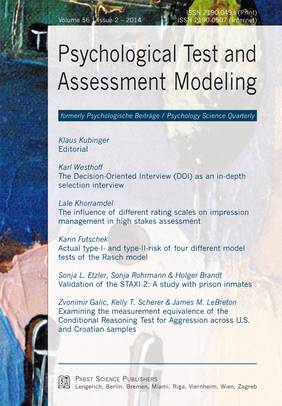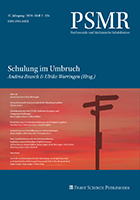Psychological Test and Assessment Modeling, Volume 56, 2014 (2)
Editorial
Klaus D. Kubinger![]() PDF of the full article
PDF of the full article
The Decision-Oriented Interview (DOI) as an in-depth selection interview
Karl Westhoff
Abstract | ![]() PDF of the full article
PDF of the full article
The influence of different rating scales on impression management in high stakes assessment
Lale Khorramdel
Abstract | ![]() PDF of the full article
PDF of the full article
Actual type-I- and type-II-risk of four different model tests of the Rasch model
Karin Futschek
Abstract | ![]() PDF of the full article
PDF of the full article
Validation of the STAXI-2: A study with prison inmates
Sonja L. Etzler, Sonja Rohrmann & Holger Brandt
Abstract | ![]() PDF of the full article
PDF of the full article
Examining the measurement equivalence of the Conditional Reasoning Test for Aggression across U.S. and Croatian samples
Zvonimir Galić, Kelly T. Scherer & James M. LeBreton
Abstract | ![]() PDF of the full article
PDF of the full article
The Decision-Oriented Interview (DOI) as an in-depth selection interview
Karl Westhoff
Abstract
The Decision-Oriented Interview (DOI) as an in-depth selection interview technique is presented. The core idea of the Decision-Oriented Interview is described. Questions in a DOI are depicted in detail and then the interview guide for the DOI is characterized with its functions and features. A typical part of an interview guide for the description of behavior in a performance-differentiating situation illustrates the decision-oriented approach. In the outlook it is shown that the DOI rules can be very helpful in many fields of applied psychology as well as for collecting the very first information in a field of psychological research or test development.
Key words: in-depth interview, selection interview, Decision-Oriented Interview, interview guide, interview rules, checklists, Decision-Oriented Assessment
Prof.em. Dr. Karl Westhoff
Wiesenstraße 63a
51371 Leverkusen, Germany
Karl.Westhoff@tu-dresden.de
The influence of different rating scales on impression management in high stakes assessment
Lale Khorramdel
Abstract
The impact of different rating scales on intentional response distortion in personality questionnaires in high stakes assessment was investigated by administering the Personality Research Form (PRF; Stumpf, Angleitner, Wieck, Jackson, & Beloch-Till, 1984) to 268 applicants in real selection situations. The applicants responded with either a 6-point rating scale (n = 184) or a 2-point rating scale (n = 84). It was hypothesised that a 6-point rating scale leads to less intentional response distortion than a 2-point rating scale, as it might be more difficult to adjust responses to a faking good schema. Both applicant groups were additionally compared to a volunteer sample (n = 184) randomly selected from the PRF norm sample. Results provide evidence of faking tendencies in the applicant samples and show an advantage of the 6-point rating scale (less faking tendencies). Moreover, it is assumed that the type of response format might interact with item content and wording. Nevertheless, even the applicant group with the 6-point rating scale seems to have faked responses compared to a volunteer sample.
Key words: high stakes assessment, impression management, rating scales, response behaviour
Lale Khorramdel, PhD
University of Vienna
Liebiggasse 5
1010 Vienna, Austria
lale.khorramdel@univie.ac.at
Actual type-I- and type-II-risk of four different model tests of the Rasch model
Karin Futschek
Abstract
To prove whether the Rasch model holds for a certain achievement test, several model tests are available. Unfortunately the actual type-I- and type-II-risks of these tests are widely unknown. A simulation study was done to compare four model tests regarding their type-I- and type-II-risk: Andersen's Likelihood-Ratio test (Andersen, 1973), the z-Test of Fischer and Scheiblechner (1970) with estimation of Wald (1943), the Martin-Löf test (Martin-Löf, 1973) as well as the new approach of Kubinger, Rasch, and Yanagida (2009) who proposed a three-way nested analysis of variance. Different scenarios were simulated: No violation of the model, violation by one pair of DIF (differential item functioning) and violation of the model due to no one-dimensional but a multi-dimensional given ability. Depending on the scenario different model tests turned out to be advantageous. For all the simulated conditions it was shown, that the analysis of variance approach is an alternative to Andersen's Likelihood-Ratio test.
Keywords: type- I -and type-II-risk; Andersen's Likelihood-Ratio test; analysis of variance; z-Test of Fischer and Scheiblechner; Martin-Löf test
Karin Futschek, MSc
Division of Psychological Assessment and Applied Psychometrics
Faculty of Psychology
University of Vienna
Vienna Austria
karin.futschek@univie.ac.at
Validation of the STAXI-2: A study with prison inmates
Sonja L. Etzler, Sonja Rohrmann & Holger Brandt
Abstract
This study investigates the reliability and validity of the State-Trait-Anger-Expression-Inventory-2
(STAXI-2; in the German version by Rohrmann et al., 2013) in a sample of n=57 male inmates (aged 25-67 years). Internal consistencies reveal a high reliability of the STAXI-2 and subscale intercorrelations are close to those of the standardization sample. A confirmatory factor analysis confirms the four-dispositional-factor structure of the STAXI-2. Construct validity is supported by correlations with personality traits of inmates that play a key role in inmate misconduct (e.g., aggressiveness & social adjustment). Anger-Expression-Out and Anger-Expression-In are significant predictors of the length of sentence and Trait-Anger is associated with the age of first offense, both indicating criterion-related validity. These results support the use of the STAXI-2 for inmates and suggest that it can serve as an diagnostic tool in correctional institutions.
Keywords: STAXI-2, Anger, inmates, validity
Sonja Etzler, PhD
Goethe University Frankfurt
Department of Psychology
Grüneburgplatz 1
60323 Frankfurt, Germany
etzler@psych.uni-frankfurt.de
Examining the measurement equivalence of the Conditional Reasoning Test for Aggression across U.S. and Croatian samples
Zvonimir Galić, Kelly T. Scherer & James M. LeBreton
Abstract
The Conditional Reasoning Test for Aggression (CRT-A; James et al., 2005) is based on the ideas that aggressive individuals use motive-based cognitive biases to see their behavior as reasonable and that those biases can be measured with specially designed inductive reasoning tasks. The test has shown promising psychometric characteristics for U. S. samples but has not been validated in other cultural contexts. In our study, we examined whether the items from the CRT-A were invariant across culture by testing whether these items displayed differential item functioning (DIF) across Croatian (N=530) and U.S. (N=1479) samples. The Lord's Chi Square (Lord, 1980), the Raju UA index (Raju, 1988), the Mantel-Haenszel procedure (Mantel & Haenszel, 1959), and the logistic regression procedures (Swaminathan & Rogers, 1990) revealed that DIF was pervasive. Although an implicit measure of personality, the CRT-A seems susceptible to differential item functioning in another culture.
Keywords: Conditional Reasoning Test for Aggression, differential item functioning, implicit personality
Zvonimir Galić, PhD
Department of psychology
University of Zagreb
Luciceva 3
10 000 Zagreb, Croatia
zvonimir.galic@ffzg.hr























